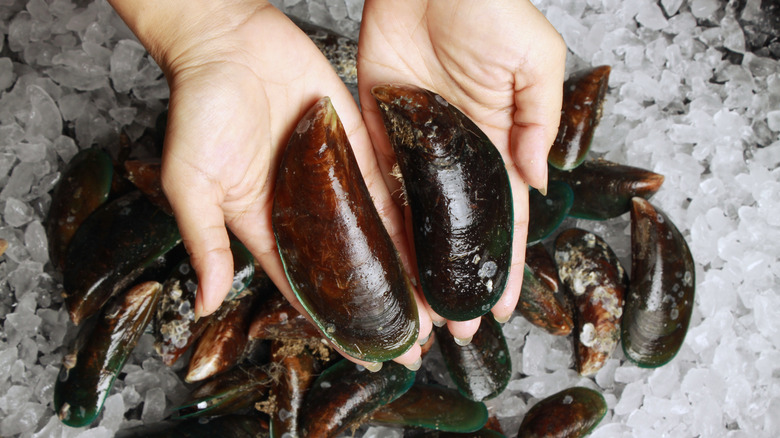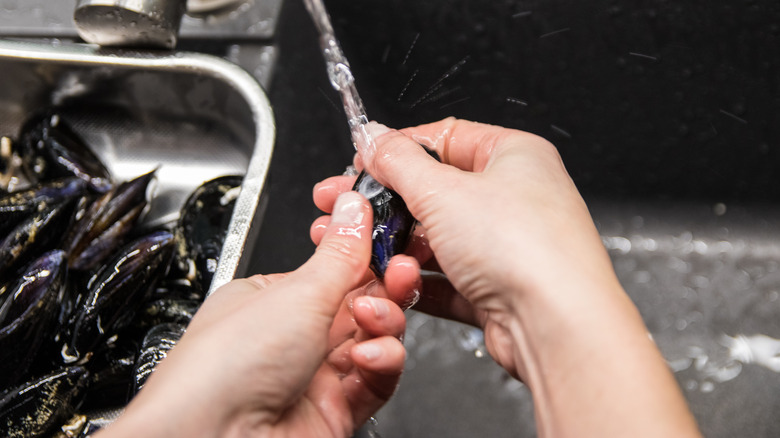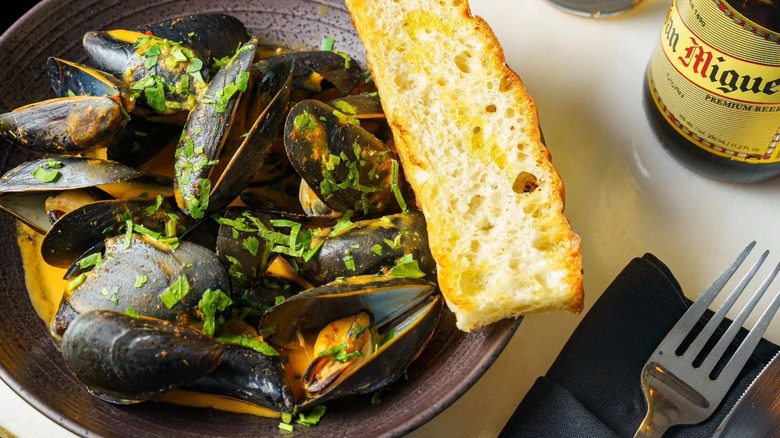Tips For Properly Storing And Cleaning Mussels, According To A Chef
There's nothing like a bowl of steamed mussels in a delicious broth, with some toasted bread or crispy french fries for dunking. However, the prospect of buying and preparing these shellfish can be intimidating. Food Republic spoke to chef Aris Tuazon of 87 Ludlow in New York City to get his tips for preparing mussels, so you don't have to go to a restaurant every time you get a craving.
The key to making delicious (and safe) mussels is to keep them alive until you cook them. Don't just cross your fingers and hope for the best on your way home from the market. Tuazon says that "you must ask for ice for the trip home," calling it "the most crucial part" of keeping mussels fresh. Ask for a bag of ice to go, and don't take the mussels off the ice until you get home.
When you get home, Tuazon instructs to wash the mussels in cold running water. Keep an eye out for any that have broken shells, an "off" smell, or do not close when tapped with one finger. Mussels with these traits should be tossed in the trash. You can stash mussels in the fridge for two to three days, though it is best to use them ASAP. Keep them in an open container with a damp towel over the top. You can store them over a container of ice to keep them cold, but don't submerge them in water until right before you cook them.
Clean mussels again before you cook them
Before you prepare these delectable mollusks, Aris Tuazon advises to soak them in cold water before cooking. The mussels will expel any grit trapped inside their shells in a process called purging. Though most mussels sold in grocery stores are already pretty clean, this step is worth it — no one likes crunching on sand in their dinner. You can also try Ina Garten's flour hack to clean sandy mussels.
Once about 20 minutes have passed, carefully lift the shellfish out of the water with your hands, rather than using a strainer. A strainer can disturb and lift up the sediment that's settled at the bottom of the bowl, making your mussels dirty again. Lastly, pull off any lingering beards on your mussels. These are the byssal threads that mussels use to anchor themselves to rocks or other mussels. Typically, they'll have already been removed by your fishmonger, but there may be some stray strands left over.
Finally, if you've stored your mussels for a few days in the fridge, a moment to inspect them to make sure they are all still alive and responsive. Also, give them a good sniff — they should smell pleasantly fresh and salty, like the ocean. These are signs of fresh mussels that will be delectable when cooked.
Delicious ways to prepare fresh mussels
A classic way to prepare mussels is to steam them gently in a flavorful cooking liquid. Wine- or broth-steamed mussels are indeed delicious, but you can also get more creative. At 87 Ludlow, which focuses on Filipino-Spanish tapas, Aris Tuazon loves to "cook the mussels in a broth with some butter, garlic and panang curry, which has a spicy, zesty, coconut-y flavor." Panang curry paste is made with ingredients with plenty of heat, a bright citrus zip, and deeply umami flavors. In both homemade recipes and pre-made pastes, you might find dried Thai red chiles, lemongrass, galangal, makrut lime zest, cilantro roots, garlic, shallots, shrimp paste, cumin, coriander seeds, nutmeg, and/or peanuts.
For the most flavorful panang curry, start by scooping off the topmost layer of a can of coconut milk. This separated layer is mostly fat, and it's used to sizzle the curry paste in a hot pan and "bloom" the spices and other ingredients, opening up all those vibrant flavors. Incorporate some stock or broth if you want the final curry sauce on the thinner side, or use only coconut milk as your base to make it more thick and creamy. Once you add the mussels to the curry, wait for them to pop open, which shows that they're done. This should take just five to seven minutes. Tuazon says he loves to serve the "fragrant, rich, brothy dish" with buttered and toasted sourdough bread for soaking up the broth.



